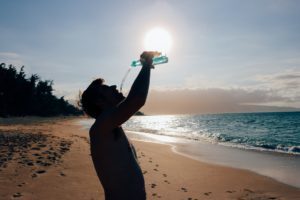
Hydration…
By the end of this article you’ll have a simple but effective guideline for your daily water intake.
The goal of hydration is to prevent fluid loss, which leads to dehydration.
Our bodies are mostly water (at least 2/3rds of our bodies are composed of water). Therefore, water is essential. For example, our muscles are mostly made up of water and protein, so without drinking sufficient amounts of water, we can experience muscle cramping.
We need water for:
- Lubricating our joints and hydrating our connective tissue
- Moving nutrients where they are needed and removing waste
- Keeping us cool through perspiration
Dehydration can do the following:
1% loss – mild dehydration – thirst occurs and the ability to regulate your body temperature starts to become impaired
2%-3% loss – thirst increases and vague body discomfort begins, as well as loss of appetite
4% loss – decreases of 20-30% work capacity are seen, therefore, athletic and work performance is significantly impaired
5% loss – cognitive impairment (difficulty concentrating), headaches, sleepiness
6% loss – numbness and tingling in the extremities (hands and feet) can be experienced
7% loss – fainting/collapsing can occur
10% loss – life threatening
Note: There’s a relationship between inadequate hydration (chronic dehydration) and urinary tract infections, dental disease, broncho-pulmonary disorders, constipation, and impaired cognitive function
The recommendation, the confusion, and the simple solution
In 2004 the Institute of Medicine (IOM) recommended that adult men take in 125 ounces of water a day (15+ cups) and adult women take in 91 ounces of water a day (11 + cups). The complication here is that this recommendation is for all water taken in, which includes beverages and food. A good way to think of it is that for the most part 80% of our water comes from the beverages that we drink and 20% from the foods that we eat.
A few of the Individual variables that increase or decrease your need for water are:
- Your body weight
- Level of physical activity
- The foods you eat
- Your sweat rate
- Your environment
The simple solution is to drink water as your main source of hydration and limit the amount of additional beverages you take in throughout the day. Since 80% of hydration comes from what you drink, the “average” human (which pertains to most of us) will stay well hydrated by:
- Drinking half your bodyweight in ounces of water per day
- Adding an additional 12 ounces of water intake for every 30 minutes of vigorous exercises/physical activity per day
- For those who will consume more than just water throughout the day, a proposed beverage guideline can be found at here.
Note: special considerations for the athlete will be reviewed in a future article
Don’t stay thirsty my friends!
References:
Miller, Gabrielle, Caitlin Merlo, Zewditu Demissie, Sarah Sliwa, and Sohyun Park. “Trends in Beverage Consumption Among High School Students — United States, 2007–2015.” MMWR. Morbidity and Mortality Weekly Report 66.4 (2017): 112-16. Web.
“Healthy Beverage Guidelines.” The Nutrition Source. N.p., 26 May 2015. Web. 14 June 2017.
“Water in diet.” MedlinePlus Medical Encyclopedia. N.p., n.d. Web. 14 June 2017.
“Water sanitation and health.” World Health Organization. World Health Organization, n.d. Web. 14 June 2017.






